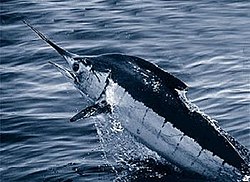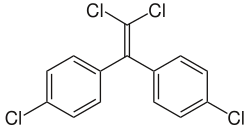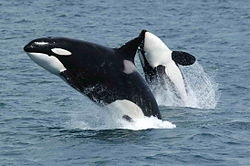Bioaccumulation is the gradual accumulation of substances, such as pesticides or other chemicals, in an organism. Bioaccumulation occurs when an organism...
20 KB (2,276 words) - 20:51, 26 February 2025
transport, which allows them to travel far from their source, and bioaccumulation, which reconcentrates these chemical compounds to potentially dangerous...
43 KB (5,526 words) - 15:06, 10 April 2025
because of their contributions to ozone depletion, global warming, bioaccumulation, and toxicity. The area of organofluorine chemistry often requires...
41 KB (4,536 words) - 14:00, 30 April 2025
Biosorption (section Differences from bioaccumulation)
biomass which resulted in a shift in research from bioaccumulation to biosorption. Though bioaccumulation and biosorption are used synonymously, they are...
11 KB (1,424 words) - 17:15, 5 April 2025
Creosote (section Bioaccumulation)
effects. Bioaccumulation is the process by which an organism takes in chemicals through ingestion, exposure, and inhalation. Bioaccumulation is broken...
95 KB (10,410 words) - 21:17, 25 November 2024
interchangeably with "bioaccumulation", an important distinction is drawn between the two, and with bioconcentration. Bioaccumulation occurs within a trophic...
11 KB (1,284 words) - 07:52, 23 January 2025
the food web Bioaccumulation controls internal concentrations of pollutants, including PFAS, in individual organisms. When bioaccumulation is looked at...
161 KB (16,605 words) - 07:40, 15 May 2025
Triclosan (section Bioaccumulation)
which potentially endangers marine organisms and may lead to further bioaccumulation. Ozone is considered to be an effective tool for removing triclosan...
60 KB (6,624 words) - 11:08, 15 May 2025
Ciguatoxin (section Bioaccumulation)
Ciguatoxins are a class of toxic polycyclic polyethers found in fish that cause ciguatera. There are several different chemicals in this class. "CTX" is...
4 KB (471 words) - 15:17, 18 September 2024
Parabens are organic compounds that are commonly used as preservatives in cosmetic and pharmaceutical products. They are esters of parahydroxybenzoic acid...
19 KB (2,317 words) - 23:03, 14 April 2025
nontarget organisms. TBT toxicity can lead to biomagnification or bioaccumulation within such nontarget organisms like invertebrates, vertebrates, and...
25 KB (3,039 words) - 15:24, 1 April 2024
Atlantic blue marlin (section Bioaccumulation)
known to accumulate in the Atlantic blue marlin, a process known as bioaccumulation. In 2017, the Texas Parks and Wildlife Department issued a consumption...
28 KB (3,223 words) - 09:40, 25 November 2024
Because of these factors PBTs have been observed to have a high order of bioaccumulation and biomagnification, very long retention times in various media, and...
22 KB (3,061 words) - 12:46, 11 April 2025
Mesopelagic zone (section Bioaccumulation)
approximately 200 fish sampled in the North Atlantic had consumed plastic. Bioaccumulation (a buildup of a certain substance in the adipose tissue) and biomagnification...
50 KB (6,021 words) - 06:42, 16 March 2025
cadmium sulfide (CdS). It is used for its fluorescent properties. Bioaccumulation of this chemical may occur along the food chain, for example in plants...
3 KB (345 words) - 21:40, 21 December 2023
caterpillars, and termites. It is not highly toxic to mammals, but bioaccumulation may be a concern. It has a low level of toxicity to birds and moderate...
3 KB (152 words) - 19:39, 31 March 2025
considered water-cleaning ecosystem engineers. They are also important in bioaccumulation and, as a result, as indicator organisms. Filter feeders can be sessile...
28 KB (3,348 words) - 09:48, 29 January 2025
chronic toxicity or the consequences of bioaccumulation since siloxanes can be long-lived. Findings about bioaccumulation have been largely based on laboratory...
15 KB (1,529 words) - 10:37, 16 May 2025
assess bioaccumulation and bioconcentration. These include: octanol-water partition coefficients (KOW), bioconcentration factors (BCF), bioaccumulation factors...
16 KB (1,887 words) - 17:00, 26 November 2024
accumulation over an organism's lifetime, this stability leads to bioaccumulation in the environment, which amplifies DDE's negative effects. DDE is...
11 KB (951 words) - 00:49, 28 December 2024
nanoplastics (MNPs) are ingestion, inhalation, and dermal contact, with bioaccumulation varying based on particle size, composition, and physicochemical characteristics...
59 KB (6,429 words) - 09:48, 24 April 2025
groundwater at sites across the United States. The toxicity, mobility and bioaccumulation potential of PFOS and PFOA pose potential adverse effects for the environment...
125 KB (13,081 words) - 22:48, 15 May 2025
are, however, so poorly soluble that this hinders their bioaccumulation. Bioaccumulation is followed by biomagnification. Lipid-soluble compounds are...
87 KB (10,768 words) - 23:44, 17 February 2025
are now are heavily regulated or banned in many regions because of bioaccumulation and potential toxicity hazards. Most industries are now transitioning...
18 KB (1,709 words) - 05:51, 6 March 2025
organomercury compound. This element is known to bioaccumulate in humans, so bioaccumulation in seafood carries over into human populations, where it can result...
75 KB (7,434 words) - 03:13, 18 May 2025
Piertney, Stuart B.; Fujii, Toyonobu; Zhang, Zulin (13 February 2017). "Bioaccumulation of persistent organic pollutants in the deepest ocean fauna". Nature...
34 KB (3,464 words) - 19:20, 3 February 2025
S2CID 219476361. Morel FM, Kraepiel AM, Amyot M (1998). "The chemical cycle and bioaccumulation of mercury". Annual Review of Ecology and Systematics. 29 (1): 543–66...
152 KB (16,161 words) - 19:07, 14 May 2025
trophic levels, the orca is particularly at risk of poisoning from bioaccumulation of toxins, including Polychlorinated biphenyls (PCBs). European harbour...
146 KB (15,085 words) - 21:30, 13 May 2025
barbiturates have half-lives of a day or more, and subsequently result in bioaccumulation of the drug in the system. The therapeutic and recreational effects...
44 KB (4,716 words) - 05:33, 11 May 2025
the likely deleterious effects it could have on organisms through bioaccumulation, association with particulate matters, and sorption. Not until about...
94 KB (11,364 words) - 08:27, 11 May 2025





















